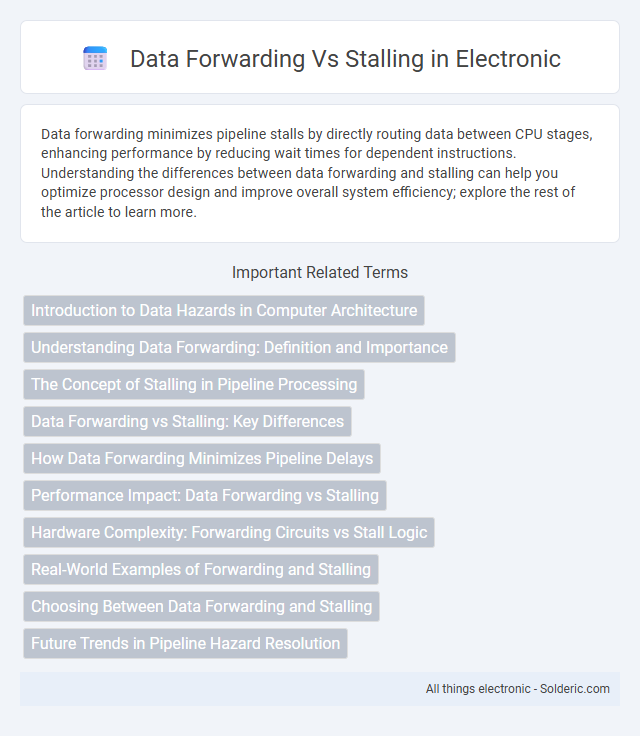Data forwarding minimizes pipeline stalls by directly routing data between CPU stages, enhancing performance by reducing wait times for dependent instructions. Understanding the differences between data forwarding and stalling can help you optimize processor design and improve overall system efficiency; explore the rest of the article to learn more.
Comparison Table
| Aspect | Data Forwarding | Stalling |
|---|---|---|
| Definition | Technique to bypass data hazards by directly passing data between pipeline stages. | Technique to handle data hazards by pausing the pipeline until the required data is available. |
| Purpose | Reduce pipeline stalls by providing up-to-date data immediately. | Delay instruction execution to avoid using incorrect or unavailable data. |
| Performance Impact | Improves performance by minimizing stalls. | Degrades performance due to pipeline bubbles and idle cycles. |
| Hardware Complexity | Requires additional forwarding paths and control logic. | Simpler hardware, uses control signals to pause pipeline stages. |
| Use Case | Common in modern pipelined processors to handle read-after-write hazards efficiently. | Used when forwarding cannot resolve hazards or in simpler processors. |
| Examples | Forwarding ALU output to subsequent instructions in execution stage. | Inserting NOPs (no operations) in pipeline to wait for data readiness. |
Introduction to Data Hazards in Computer Architecture
Data hazards in computer architecture occur when instructions depend on the results of previous instructions, causing potential conflicts during pipeline execution. Data forwarding resolves these hazards by directly routing the required data from one pipeline stage to another without waiting for it to be written back to registers, minimizing stalls. Stalling introduces deliberate delays by pausing instruction execution until previous instructions complete, preserving data integrity but reducing performance; understanding these mechanisms helps optimize Your CPU pipeline efficiency.
Understanding Data Forwarding: Definition and Importance
Data forwarding is a technique used in pipelined processors to resolve data hazards by directly routing the needed data from one pipeline stage to another without waiting for it to be written back to the register file. This method significantly reduces pipeline stalls and improves instruction throughput by enabling dependent instructions to use the most recent data immediately. Understanding data forwarding is crucial for optimizing CPU performance and minimizing delays caused by instruction dependencies.
The Concept of Stalling in Pipeline Processing
Stalling in pipeline processing occurs when the pipeline must pause instruction execution to resolve data hazards, preventing incorrect or premature data use. It introduces delay cycles, known as bubbles, that halt the progress of subsequent instructions until data dependencies are cleared. Data forwarding mitigates stalling by rerouting intermediate results directly between pipeline stages, reducing pipeline stalls and improving overall CPU throughput.
Data Forwarding vs Stalling: Key Differences
Data forwarding minimizes pipeline stalls by directly routing data from one pipeline stage to another, ensuring faster instruction execution and improved CPU efficiency. Stalling, on the other hand, introduces deliberate delays or pipeline bubbles to wait for data dependencies to resolve, which can reduce overall performance. Understanding the key differences between data forwarding and stalling helps optimize your processor's instruction pipeline for better throughput and reduced latency.
How Data Forwarding Minimizes Pipeline Delays
Data forwarding minimizes pipeline delays by directly transferring the output of one pipeline stage to a subsequent stage needing that data, bypassing the need to wait for register write-back and read stages. This technique reduces hazards by eliminating the need to stall the pipeline when dependent instructions require immediate data access. By enabling faster data availability, data forwarding significantly improves instruction throughput and overall pipeline efficiency.
Performance Impact: Data Forwarding vs Stalling
Data forwarding significantly improves CPU pipeline efficiency by reducing stalls caused by data hazards, allowing dependent instructions to proceed without waiting for previous instructions to complete. Stalling, on the other hand, introduces pipeline delays that degrade overall performance by forcing the CPU to pause instruction execution until the required data is available. Optimizing your system with effective data forwarding techniques can enhance processing speed and minimize latency in instruction pipelines.
Hardware Complexity: Forwarding Circuits vs Stall Logic
Forwarding circuits increase hardware complexity by requiring additional multiplexers and control logic to detect and resolve data hazards dynamically within the pipeline. In contrast, stall logic involves simpler hardware that stalls the pipeline by freezing instruction execution until the hazard clears, but at the cost of reduced performance. The trade-off between forwarding and stalling lies in balancing increased hardware complexity for improved throughput against simpler design with potentially higher latency.
Real-World Examples of Forwarding and Stalling
In modern CPU architectures, data forwarding is exemplified by pipeline designs in processors such as the Intel Core series, where intermediate results are routed directly to dependent instructions to minimize stalls and enhance throughput. Stalling occurs prominently in early pipeline implementations or in cases of cache misses, where the processor must delay instruction execution until the required data is available, as seen in some ARM Cortex-M microcontrollers. Real-world performance benchmarks reveal that forwarding significantly boosts instruction-level parallelism, while stalling contributes to pipeline hazards and latency, highlighting the trade-offs in pipeline control mechanisms.
Choosing Between Data Forwarding and Stalling
Choosing between data forwarding and stalling depends on pipeline efficiency and hazard mitigation in CPU architecture. Data forwarding reduces delays by directly passing the result from one pipeline stage to another, minimizing performance loss, while stalling introduces pipeline bubbles to handle data hazards at the cost of throughput. You must evaluate your processor's complexity and performance needs to balance latency reduction with design simplicity.
Future Trends in Pipeline Hazard Resolution
Future trends in pipeline hazard resolution emphasize advanced data forwarding techniques combined with intelligent control logic to minimize stalling, enhancing processor throughput and efficiency. Emerging architectures integrate machine learning algorithms to predict and resolve hazards dynamically, reducing pipeline stalls caused by data dependencies. Innovations in adaptive pipeline designs leverage real-time monitoring to optimize hazard mitigation strategies, further decreasing performance penalties associated with stalling.
Data forwarding vs stalling Infographic

 solderic.com
solderic.com